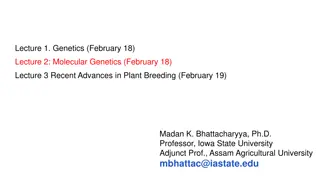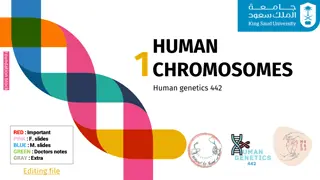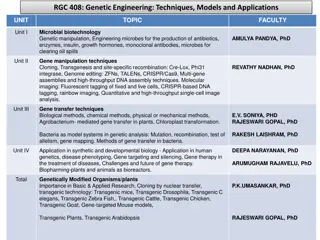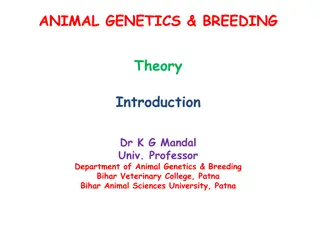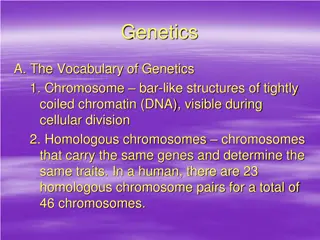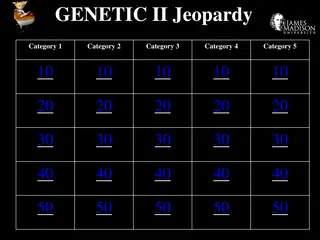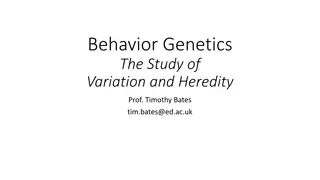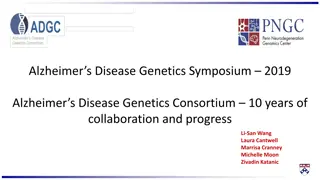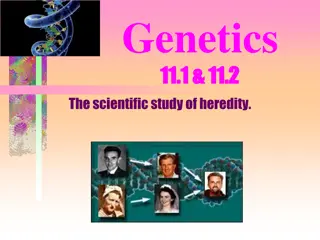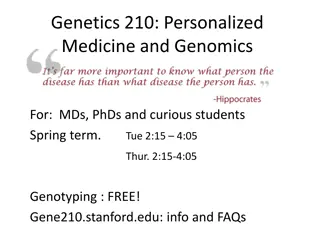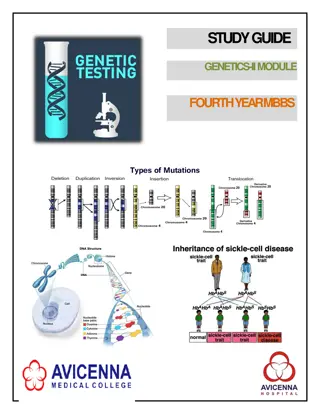Genetics in Public Health Overview
Genetics is a diverse field encompassing human genetics and medical genetics, with specialties like cytogenetics, molecular and biochemical genetics, and clinical genetics. Genetic counseling and population screening play vital roles in public health initiatives. Understanding genetic disorders is crucial in patient care and preventive medicine, highlighting the importance of genetics across clinical specialties.
Download Presentation

Please find below an Image/Link to download the presentation.
The content on the website is provided AS IS for your information and personal use only. It may not be sold, licensed, or shared on other websites without obtaining consent from the author.If you encounter any issues during the download, it is possible that the publisher has removed the file from their server.
You are allowed to download the files provided on this website for personal or commercial use, subject to the condition that they are used lawfully. All files are the property of their respective owners.
The content on the website is provided AS IS for your information and personal use only. It may not be sold, licensed, or shared on other websites without obtaining consent from the author.
E N D
Presentation Transcript
INTRODUCTION Genetics is a diverse subject, concerned with variation and heredity in all living organisms. Within this broad field, human genetics is the science of variation and heredity in human beings, and medical genetics deals with human genetic variation of medical significance. The two areas (human genetics & medical genetics) have extensive overlap, there are many fields of interest, and in fact to many geneticists they are one and the same.
Major recognized areas of specializations are: 1.CYTOGENETICS -The study of chromosomes, 2.MOLECULAR AND BIOCHEMICAL GENETICS - The study of the structure and function of individual genes, and 3.CLINICAL GENETICS-The application to diagnosis and patient care. Other fields of human genetics such as population genetics, genetic epidemiology, developmental genetics, and immunogenetics also have medical relevance, especially in relation to understanding and prevention of human diseases.
Genetic counseling, which combines the provision of risk information with a support function, is maturing into a new health profession. Population screening for genetic diseases has become an important public health initiative. Prenatal diagnosis, which makes use of many clinical and laboratory specialties in addition to genetics, is probably today the chief area in which human genetics is applied to patient care.
Although human genetics has been most closely associated with pediatrics, it is also relevant to many other clinical specialties. In obstetrics, prenatal diagnosis of certain genetics defects has become a standard aspect of prenatal care. In adult medicine, it is recognized that many common disorders, such as coronary artery disease, hypertension, and diabetes mellitus, have important genetic components, and that Preventive medicine could be much more effective if it could be directed toward special genetically defined high-risk groups rather than toward general population
Classification of Genetic Disorders Virtually any disease is the result of the combined action of genes and environment, but the relative role of the genetic component may be large or small. Among disorders caused wholly or partly by genetic factors, three main types are recognized: 1. Unifactorial diseases (Single-gene disorders or Mendelian diseases) 2. Chromosome abnormalities 3. Multifactorial disorders
Single-gene defects These defects are caused by mutant genes. The mutation can be present on only one chromosome of a pair, or on both chromosomes of the pair. In either case, the cause is a single critical error in the genetic information. Many of such defects are rare. However, there are many different kinds, and their combined impact is significant. In several hundred of these diseases, the basic biochemical defect has been recognized, and in many the affected gene has been isolated and cloned.
Single-g These are the Dominant, Recessive and sex-linked diseases. The offspring of an autosomal dominant trait has a 50:50 chances of being affected, provided the other parent is normal. (E.g. ABO system, Erythroblastosis foetalis) The offspring of an autosomal recessive trait has a 1:4 chances of being affected, provided both the parents are heterozygous. (E.g. Sickle cell anaemia, cystic fibrosis, Phenylketonuria, etc.) The mutant gene (carrier father and normal mother) is transmitted to all the daughters, but the son escapes. 50% of sons and 50% of daughters will be affected when mother is a carrier. (E.g. Haemophilia, colour blindness, G6 PD deficiencyc, etc.)
Single-g. The role of mitochondrial genes as causes of disease is now recognized, and an defect in a mitochondrial gene has been identified in several disorders. Mitochondrially transmitted diseases must therefore be recognized as a special type of single-gene disorder.
Chromosome disorders The defect is due to an excess or deficiency of the genes contained in chromosome segment or whole chromosome. For example, the presence of an extra copy of one chromosome, chromosome 21, produces a specific disorder Down syndrome, even though no individual gene on the chromosome is abnormal. As a group, chromosome disorders are quite common, affecting about 5.6 in 1000 liveborn infants (2/1000 LBs.represent Sex aneuploidies, 1.7/1000 LBs.autosomal aneuploidies and 1.9/ 1000 LBs. chromosomal translocations ) and accounting for about half of all spontaneous first-trimester abortions.
Chromos. Relating to Sex chromosomes: a) Klinefelters Syndrome -Normal autosomal set of 22 2 X chromosomes in addition to 1 Y-chromosome (XXY,XXXY) -Incidence 1 in 1000 live born males b) XYY Syndrome -The male with an extra Y-chromosome -Incidence 1 in 1000 live born males c) Turners Syndrome -45 chromosomes only & their sex chromosome is XO -Incidence 1 in 7500 live born girls d) Super Females - Females with 3-5 X chromosomes (XXX,XXXX,XXXXX)
Chromos. Relating to Autosomes: -Mongolism or Down s Syndrome or Trisomy 21 . -Extra pair which occurs at 21stpair -Incidence is 1 in 900 births
Multifactorial inheritance It is responsible for a number of developmental disorders resulting in congenital malformations and for many common disorders of adult life. Again, there appears to be no single error in the genetic information, but rather a combination of small variations that together can produce or predispose to a serious defect. The frequency of these disorders is high as compared to Mendelian and chromosomal disorders. Environmental factors may also be involved. Multifactorial disorders tend to recur in families but do not show the characteristic pedigree patterns of single-gene traits.
Multifact There are indications that most of the common disorders of adult life are conditions with a multifactorial aetiology. Few examples are: Essential hypertension Ischaemic heart disease of early onset Schizophrenia Mental retardation Duodenal ulcer Diabetes Cancers, etc
Congenital Means that a condition is present at birth.( Not all genetic disorders are congenital in terms of age of onset e.g. Huntington disease, nor are all congenital abnormalities genetic in origin e.g. fetal disruptions).
Risk One of the primary considerations in medical genetics is evaluation of the recurrence risk that is, the risk that a genetic disorder in a patient will also affect other family members. Many people are unaware, however, that any pregnancy there is an appreciable risk of an unfavorable outcome; for example, the risk of congenital abnormality in any child of any parents is about 1 in 30 and, the risk of a significant genetic disease making its appearance before the age of 25 is even higher.
Ris. The estimation of recurrence risks in different situations is the basis of genetic counseling. Information on the frequency of genetic disorders in the population as a whole is needed both to allow health care planning and to provide a baseline against which possible future changes can be measured. More than 5% of live-born persons under 25 years of age had a genetic disorder of single-gene, cytogenetic or multifactorial causation.
Baseline Risks of Abnormal Outcome of Pregnancy Risk of some congenital abnormality present at birth 1 in 30 Risk of a severe physical or mental handicap 1 in 50 Risk of serious physical or mental handicap in child of cousin parents 1 in 30 Risk of spontaneous abortion 1 in 8 Risk of perinatal death (North America) 1 in 150 Risk that a couple will be infertile 1 in 10
The Load of Genetic Disease Category Frequency (%) Single-gene Autosomal dominant 0.14 Autosomal recessive 0.17 X-linked 0.05 Total single-gene 0.36 Chromosomal Multifactorial Congenital 2.30 Other 2.40 Total multifactorial Unclassified genetic 0.19 4.70 0.12 Total 5.37
The Impact of Genetic Factors in Disease at different Age Spontaneous miscarriages In first-trimester pregnancy loss a chromosome abnormality is present in 40-50% of cases. Approximately 1 in 6 of all pregnancies results in spontaneous miscarriage, thus around 5-7% of all recognized conceptions are chromosomally abnormal. This value would be much higher if unrecognized pregnancies could also be included, and it is likely that a significant proportion of miscarriages with normal chromosomes do in fact have catastrophic submicroscopic genetic errors.
The Impact of Genet Newborn infants Of all neonates, 2-3% have at least one major congenital abnormality, of which at least 50% are caused exclusively or partially by genetic factors. The incidence of chromosome abnormalities and single-gene disorders in neonates are approximately 1 in 200 and 1 in 100, respectively.
The Impact of Genet. Childhood Genetic disorders account for 50% of all childhood blindness, 50% of all childhood deafness and 50% of all cases of severe learning difficulty. In developed countries genetic disorders and congenital malformations together also account for 30% of all childhood hospital admissions and 40-50% of all childhood deaths.
The Impact of Genet Adult life Approximately 1% of all malignancy is caused by single- gene inheritance, and between 5 to 10% of common cancers such as those of the breast, colon and ovary have a strong hereditary component. By the age of 25 years, 5% of the population will have a disorder in which genetic factors play an important role. Taking into account the genetic contribution to cancer and cardiovascular diseases, such as coronary artery occlusion and hypertension, it has been estimated that more than 50% of the older adult population in developed countries will have a genetically determined medical problem.
Preventive & Social measures 1. Health promotion measures Eugenics(science which aims to improve the genetic endowment of human population):- Negative eugenics-Aim is to reduce the frequency of hereditary disease and disability in community to as low as possible. -People suffering from serious hereditary diseases are sterilized or otherwise debarred from producing children. Positive eugenics-Aim is to improve the genetic composition of the population by encouraging the carriers of desirable genotypes to assume the burden of parenthood.
Prevent Euthenics Mutual interaction of heredity and environmental factors which enables the genes to express themselves readily Example of application of euthenics: Studies with mentally retarded (mild) children indicated that exposure to environmental stimulation improved their IQ.
Prevent Genetic Counselling A. Prospective -Prevention or reduction of heterozygous marriages so that the prospects of giving birth to affected children should be minimised -Examples conditions like Thalassemia and Sickle-cell anaemia.
Prevent B. Retrospective -Most common -Chiefly sought in connection with congenital abnormalities, mental retardation, psychiatric illness and inborn errors of metabolism -Suggested methods are: i. Contraception ii. Pregnancy termination iii.Sterilization
Prevent 2. Specific protection Protection of individuals and whole communities against mutagens -Examples: a) X-rays and other ionizing radiations, and Chemical mutagens b) Immunization with anti-D globulin in Rh haemolytic disease of the newborn
Prevent 3. Early diagnosis and treatment a) Detection of genetic carriers E.g. Duchene type of muscular dystrophy, haemophilia, galactossemia, PKU, etc. b) Prenatal diagnosis Amniocentesis- In early pregnancy (about 1-16 weeks) -Cromosomal anomalies(e.g. Down s Syn.) -Inborn errors of metabolism (e.g.Tay-Sachs disease, galactosemia, neural tube defects, etc.)
Prevent c) Screening of newborn infants Diseases like- PKU, CONGENITAL hypothyroidism, sickle cell disease, cystic fibrosis, etc. d) Recognizing preclinical cases -Glucose-tolerance test siblings and close relatives of diabetics - Serum Uric acid- Gout - GBP-Thalassemia




